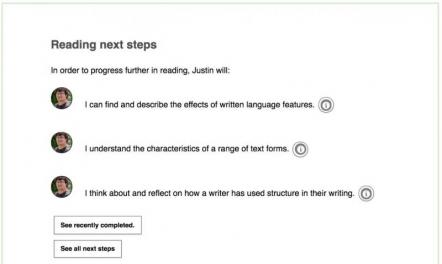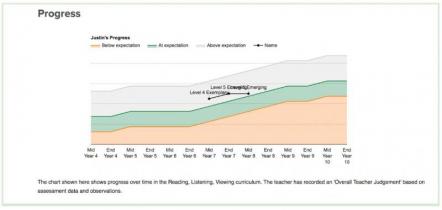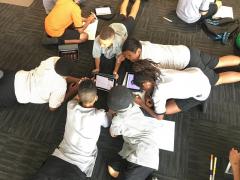Ormiston Junior College (OJC), situated at Flat Bush in East Auckland and established in February 2017, is a middle school for students from years 7 to 10. Although the student population is small at the moment, the school will eventually accommodate 1000 students.
The college is in a new building, constructed as an ILE (Innovative Learning Environment). The new design of the teaching spaces has allowed the school to develop an innovative approach to teaching and learning.
Sharing information with learners, parents, and whānau
Over the course of the term, students construct their "learning journey" or narrative assessment. This piece is co-constructed between the TAIP (Transdisciplinary Authentic Inquiry Projects) coach and MAC (Mentor Advisor Coach), with the learners leading the process and selecting the learning and meaningful artefacts and goals they will discuss or present. The Learning Journey is constructed at key milestones throughout the term and is pushed out to families at the end of each term. Writing teacher comments and narrative assessments for the Learning Journeys is a learning focus for staff this year.
This is an example of an end of term 1 narrative assessment for a year 8 student.
TAIP Coach comments:
- ...... was challenged from the start of his TAIP this term as he took some time in committing to a project idea. However, once started, his group progressed well and made some good connections to identified learning areas. ......'s TAIP focused on designing and developing an authentic and fun sporting game. An additional challenge was the ability to conduct research and combine this with practical testing in order to ensure their game benefits health and fitness, which was the main component of their learning area connection. Moving forward ...... recognised that a more concentrated focus at the start of the term will have a positive effect throughout the whole term and this is something he will take into TAIP 2.
MAC comments:
- This year ...... has focused on continuing to complete his learning to a higher standard with more consistency. His personal goal was to take the initiative and share ideas, questions and to contribute more in a wider variety of situations. He has noticeably begun to do this and seek out opportunities to test himself, and even share his quirky sense of humour more often with the group. ...... still finds speaking in front of groups difficult, but has been rising to the challenge, and has participated in targeted communication skills learning activities, and explaining his thinking more frequently and with less prompting in our MAC. ......’s ability to relate to others beyond his immediate peer group is also growing slightly, and he has been able to support new learners to understand the tasks and technology available at OJC. This is an area that is still not incredibly comfortable for ...... to work on, however his willingness to take steps to get out of his comfort zone, communicate and relate to a wider range of people in a wider range of settings is a great start this term.
- ......’s next steps are to continue to think about how he shares his ideas both formally and informally, and continue to apply strategies for verbal communication that will also help to make sure his projects or tasks for MAC are completed to the level that he his thinking at, rather than the level he is willing to communicate at.
Other parts of the reporting process
Regular use of Linc-Ed’s curriculum area goal-setting features for our Literacy and Numeracy programme to show progress live and in real- time. Teachers can see where each child is at in terms of meeting the curriculum expectations set for our school, and students can set learning goals with teachers or on their own, and load evidence to show that they have met goals. This example (in the image) shows three goals that a teacher set with the learner, and will frame the work they do next.

Select the image to view at full size.
Bi-yearly graphing of student progress against curriculum levels to show trends over time in relation to expectations in numeracy and literacy. To confirm that they are giving the students the fundamental skills to access the curriculum through this system, teachers back up their digital badging process with formal e-asTTle testing and PAT Listening for diagnostic purposes, particularly for ESOL students.

Select the image to view at full size.
Publishing of Badges with evidence as they are awarded – live and in real time. This happens at least four times each year – but can happen as and when learners are ready. (For example, Mastery/Assess when ready) When you hover on a badge, or view current badges that are set as goals, the criteria for the badge appears. A 3 tier system – orange – emerging, green – effective, and black – exemplary differentiates levels of achievement for each badge. Learners are able to “level up” and re-do badges at higher levels, and do not have to work through each level. This system is intended to mimic the current NCEA achieved, merit, excellence, and is loosely based on the solo differentiation between levels of understanding. The school avoided using the A, M, E or BPA language intentionally to avoid confusion and wanted to stick to using only three to best help learners prepare for what was to come while having to unpack what the difference is between each level of understanding.

Select the image to view at full size.
The Whānau Ora also sends out learning stories which capture the learning in this part of the curriculum. These stories are pushed out at the end of each Whanau Ora Option " every 7 weeks. Read this sample Whānau Ora Learning Journey.
Three mid-term (terms 2, 3, and 4) dispositions reflections are completed as self-evaluations and as teacher feedback and feedforward to help frame where students are at in terms of their learning attitudes, behaviours and perceptions of themselves as learners. This is done mid term in order to provide communication with home about how the home school partnership can support personalised dispositional goals as they are needed to foster improvement – rather than as summative (or “too late”) information at the end of the term.
All reporting documents are developed in collaboration with learners live and in real time during class time. Teachers are expected to use class time to work with the learners to complete each piece, with the exception of their comments, editing, and bi-yearly graphing. This is to ensure the assessing and reporting are deeply connected to the learning and to the learners, and there is clarity in the purpose and intentions of each element in terms of nurturing next steps and growth and improvement.





